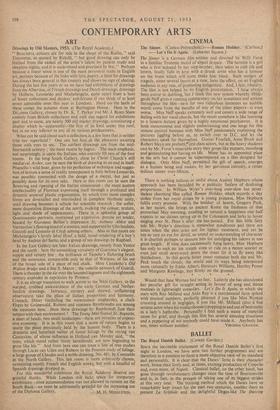CONTEMPORARY ARTS
ART
Drawings by Old Masters, 1953. -(The Royal Academy.) " BEAUTIFUL colours are for sale in the shops of the Rialto," said Tintoretto, as quoted by Ridolfi, " but good drawing can only be fetched from the casket of the artist's talent by patient study and sleepless nights, and it is understood and practised by few." Perhaps because a linear sense is one of the most persistent traits in English art, perhaps because of the links with lyric poetry, a taste for drawings has always been general in this country and shows no sign of abating. During the last five years or so we have had exhibitions of drawings from the Albertina, of French drawings and Dutch drawings, drawings by Holbein, Leonardo and Michelangelo, quite apart from a host of lesser collections and dealers' exhibitions (I can think of at least seven admirable ones this year in London). Hard on the heels of these comes the autumn show at Burlington House. Here in the Ditpoma Gallery, chosen by Dr. K. T. Parker and Mr. J. Byam Shaw entirely from British collections and with due regard for exhibitions past and to come, are nearly 500 old master drawings, constituting a display which is—apparently—the fist of its kind under this roof, but in no way inferior to any of its various predecessors.
What can be said about such a collection in a few lines that is neither trite nor superficial ? One can but hint at the pleasures awaiting those with eyes to see. The earliest drawings are from the mid- fourteenth century ; the most recent by 'Ingres. The main emphasis, not surprisingly, is upon the Italians, who entirely fill two of the four rooms. In the long South Gallery, close by Christ ChUrch's still mediaeval Archer, can be seen the birth of drawing as an end in itself. Pisanello's wild boar, given by his perfection of technique and sugges- tion of texture a sense of reality unsurpassed in Italy before Leonardo, was possibly connected with the design of a medal, but just as possibly done for its own sake. Here in this room can be seen the flowering and ripening of the Italian renaissance : the more austere intellectuality of Florence expressing itself through a profound and dynamic sense«of plastic organisation, by which ever more complex forms are dovetailed and interlocked in complete rhythmic unity, until drawing becomes a vehicle for scientific research ; the softer, more decorative drawings of the north, evoking the colour, texture, light and shade of appearances. There is a splendid group of Quattrocento portraits, restrained yet expressive, precise yet tender, headed by Giovanni Bellini's impressive St, Anthony Abbot and Verrocchio 's flowing head of a woman, and supported by Ghirlandaio, Gozzoli and Lorenz.° di Credi among others. Also in this room are Michelangelo's lovely Ideal Head, a bold, tonal rendering of a boy's head by Andrea del Sarto, and a group of ten drawings by Raphael.
In the East Gallery are later Italian drawings, mostly from Venice and the north : here the astonishing virtuosity of Guercino's elegant, supple and velvety line ; the brilliance of Tiepolo's flickering brush and the assurance, comparable only to that of Watteau, of his use of the broad side of a piece of red chalk. Here Canaletto's Old Walton Bridge and a fine S. Marco ; the volatile penwork of Guardi. There is thunder in the air over the haunted lagoons and the eighteenth century explodes in capriccios by Piranesi. It is an abrupt transition to walk across to the West Gallery, to the warped, crabbed awkwardness of the early German and Nether- landish drawings. Intricacy, mystery and shrewd, unflattering observation take the place of Italian proportion and harmony. Cranach, Dilrer (including the watercolour stagbeetle), a chalk Virgin by Grilnewald, Rubens and nineteen Rembrandts are among the treasures here. How these drawings by Rembrandt fuse their subject with their environment ! The Young Man Seated, St. Augustin, a sheet of heads, two small landscapes—these are miracles of expres- sive economy. It is in this room that a sense of nature begins to usurp the place previously held by the human body. There is a dramatic and luxuriant welter of forest foliage by the roving van Coninxloo, of whose influence in Holland van Mander said, " the trees, which stood rather thinly hereabouts, are now beginning to grow like his." And from here one can trace a line of tree studies through Lucas van Uden and Rubens to the Poussin study of foliage, a large group of Claudes and a noble drawing, No. 481, by Constable in the North Gallery. This last room is more arbitrarily chosen, containing mostly French and English works, but with a handful of Spanish drawings dropped in.
For this wonderful exhibition the Royal Academy deserve our grateful thanks. While London still lacks space for temporary exhibitions—since accommodation was not allowed to remain on the South Bank—we must be additionally grateful for the increasing use


























 Previous page
Previous page